Today we celebrate the International Day of Forests, a day where people across the globe commemorate and raise awareness of the importance of all types of forests.
This year’s theme – Forests and sustainable production and consumption – reminds us to think critically about our habits and consumption. Whether we are drinking a glass of water, reading a novel, or buying furniture, our everyday habits connect back to forests in one way or another.
Forests are essential to the health and well-being of humans and animals. That’s why Tree Canada has worked with sponsors and partners since 1992 to plant millions of trees – including through our National Greening Program, which contributes to the restoration of forests and wildlife habitat.
To mark the International Day of Forests, we’re highlighting five forests from across the world that have an enormous impact on their local communities and the health of our planet.
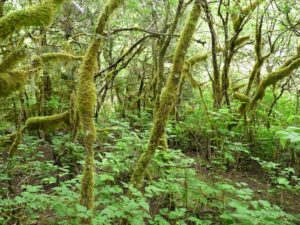
Great Bear Rainforest
The Great Bear Rainforest (GBR) is the world’s largest intact coastal rainforest on the north and central coast of British Columbia. Reaching from the northern tip of Vancouver Island to just south of Alaska, it spans 64,000 km2 or 6.4 million hectares of land. In 2016, a historic agreement was announced to permanently conserve 85% of the forest and 70% of the old-growth forest from industrial logging.
What makes this forest so unique?
The Great Bear Rainforest is home to a very diverse species of fauna, including the famous cream-coloured Spirit Bear. But don’t be fooled by the name, the GBR is not just a terrestrial forest. It is also home to some of the world’s largest kelp forests and diverse flora, including spruce and cedar trees that are over 1000 years old and Sitka spruce trees that stand 90 meters tall! Their proximity to the ocean along with the cool temperatures offered by the mountains creates a high precipitation environment, allowing these trees to reach such impressive heights.
The Great Bear Rainforest is home to many First Nations, nine of which came together to form the Coastal First Nations – Great Bear Initiative in 2003. This alliance was envisioned to demonstrate First Nation leadership in restoring sustainable resource management and to improve the quality of life for the First Nations on their traditional lands.
From its sheer size to the diversity of flora and fauna within it and the critical forest management practices of the Coastal First Nations, the Great Bear Rainforest is truly a forest to admire.
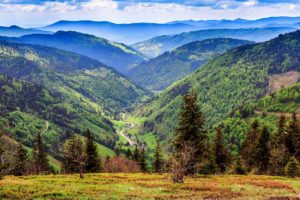 Black Forest
Black Forest
Covering 6,000 km2 in southwestern Germany, the Black Forest is made of tree species such as oak and birch in the valleys, and fir, pine, and spruce at higher elevations.
What makes this forest so unique?
The Black Forest, named because of its deep, dark pine, spruce, and fir trees, is an example of human communities that are deeply intertwined with the natural environment. While there are natural resource industries in the region, including mining and forestry, the extensive farming, clockmaking and natural tourism industries are also vital to the region’s culture of sustainable forest living. The castles, towns, and farms in the region date back to the medieval area, though people lived in the area long before. The mountainous region is also filled with folklore, with stories about trolls, fairies, and other natural myths that contribute to its rich history.
Before forest bathing became a recognized term, Germans would flock to the Black Forest to alleviate their stress in the spas, mineral springs and tranquillity of the forest and towns. The Black Forest truly is an example of where culture and nature can meet in harmony.
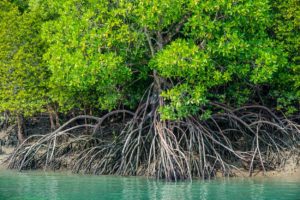 Sundarbans Mangrove Forest
Sundarbans Mangrove Forest
The Sundarbans represent the world’s largest single mangrove ecosystem, covering an area of 10,100 km2, located at the northern limits of the Bay of Bengal and the old Ganges Delta, in Bangladesh and eastern India. A mangrove is a type of tree or shrub that grows in the intertidal zones of warm, slightly salty (brackish) water, typically on coastal wetlands. Approximately half of the Sundarbans is said to be inhabited, with 327 village clusters and approximately 4.5 million people living in the region.
What makes this forest so unique?
The Sundarbans Reserved Forest, located within the Sundarbans, is recognized as an internationally important World Heritage and Ramsar site. This forest plays a pivotal role in protecting coastal areas from the impact of cyclones in the Bay of Bengal, helping land maturation by slowing the velocity of the water flow, reducing erosion, and allowing sediments from the Himalayas to settle.
Importantly, mangrove forests are tremendous carbon sinks. Compared to rainforests, it is estimated that they store 5-10 times more carbon per acre. The deep, nutrient-rich soil that accumulates from river sediment and decomposing organic matter contributes significantly to above- and below-ground carbon stocks. This is referred to as “blue carbon” and the Sundarbans have some of the highest blue carbon stocks globally. This also provides nutrients and habitat for fish and wildlife species, allowing the Sundarbans to host an incredible diversity of fauna and salt-tolerant flora.
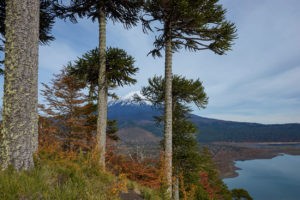 Andean Patagonian Forest
Andean Patagonian Forest
The Andean Patagonian Forest, also known as a subantarctic forest, spreads across southern Chile and Argentina in South America. This temperate forest is one of the most southern forests in the world and covers approximately 6.5 million hectares. The forest can be divided into four regions: deciduous forest, Magellanic subpolar forests, Valdivian temperate forest, and the Del Pehuén.
What makes this forest so unique?
The Andean Patagonian Forest dates back 45 million years ago and can trace back ancestors to when the region was a part of the Gondwana supercontinent. It is one of the few undisturbed temperate forests that still exists, with little changes made by humans. Due to its archaeological history, the Andean Patagonian Forest is home to many endemic species that only exist in this one specific region. A few examples of tree species endemic to the Andean Patagonian Forest include the lenga beech, the Patagonia cypress, and the Chilean pine tree.
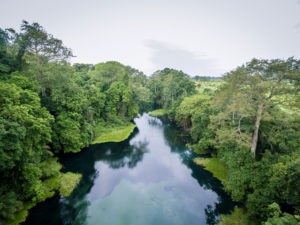 Congo Basin Rainforest
Congo Basin Rainforest
The Congo Basin Rainforest is the second largest tropical rainforest in the world and is home to over 600 tree species, 10,000 species of tropical plants and more than 75 million people, who have inhabited the region for more than 50,000 years. The forest covers 500 million acres of land and spans over six countries in Central Africa. This rainforest gets its name from its location in the Congo Basin, which drains into the Congo River, the second largest river by volume in the world!
What makes this forest so unique?
The Congo Basin Rainforest provides food, fresh water, and shelter to both humans and animals in the region. Among the 150 distinct ethnic groups that inhabit the Congo Basin, the region’s Ba’Aka people are the most well-known, with their livelihoods and well-being closely linked with the forest.
This forest is quite rich in wood, oil, and minerals. According to the World Wildlife Fund, current methods of extraction are unsustainable and threaten the future of this forest. The forest is home to many endangered species including the African forest elephant and the western lowland gorilla. As a carbon sink, this forest is extremely valuable in the fight against climate change as it sequesters 600 million metric tonnes more carbon than it emits each year.
Back to all articles